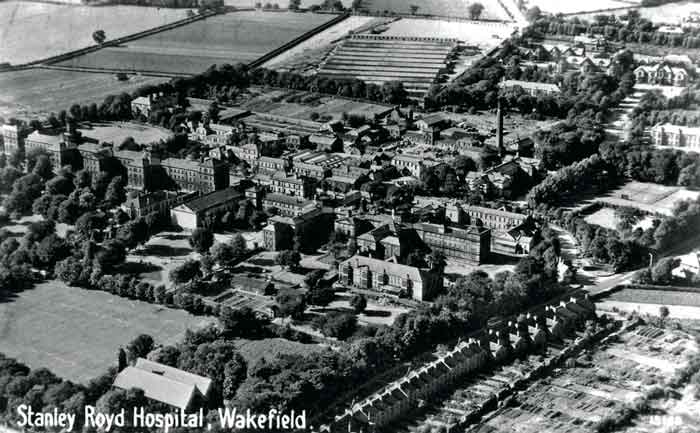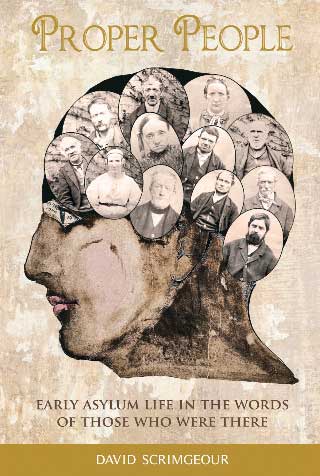
Tales from West Riding Pauper Lunatic Asylum
by Ian Dewhirst
There is already an extensive literature on the Victorian treatment of mental health, but David Scrimgeour’s study of the West Riding Pauper Lunatic Asylum at Wakefield (Wakefield Asylum) adopts the less typical viewpoint of the patients themselves.
Thanks to surviving case notes, annual reports, letters and newspaper accounts, backed up by the records of fourteen archives and museums, Mr Scrimgeour has resurrected the stories of 158 of the forgotten thousands who passed through the Asylum during the first fifty years of its existence from 1818 to 1869.
He calls his unfortunates ‘proper people’ as a play on their committal warrants declaring each a ‘proper person’ to be admitted. And what a varied, sad and sometimes intriguing collection of people they were!

Stanley Royd Hospital, Wakefield
A wood carver, discharged as recovered after eight months, who put his stay to good use carving an eagle lectern for the Asylum chapel; a Gomersal cloth weaver turned suicidal because of ‘the reading of Writings rendering him dissatisfied with his condition’; a twenty-year-old iron moulder from Halifax who thought it his duty ‘to pray on the Hills and Highways’, and who escaped only to be found drowned in the River Calder; a tailor from Bradford, ‘disappointed in love’, confined for 49 years at a total cost of £2,000; an alcoholic ‘stage player’, cured of mania within two months, who treated 400 of his fellow-patients to a dramatic entertainment which included performing dogs; a laundress, discharged to the care of her daughter after 32 years, who paid fanatical attention to her physicians’ linen, and a Sheffield housekeeper who after a brief incarceration thanked the Asylum management by way of a published poem.
There was even a young man from East Ardsley who had served as an officer throughout the American Civil War, and who may have been suffering from the then undiagnosed post-traumatic stress.
Cases of the criminally insane offer the sequel to some sensational local events. When John Holdsworth, keeper of the Hawcliffe toll bar near Keighley, shot his wife dead in l86l, he made headlines throughout the West Riding, but once found not guilty on the ground of insanity and confined during Her Majesty’s pleasure, he disappeared from the newspapers. Here, however, we follow his subsequent progress, from the Wakefield Asylum to the State Criminal Lunatic Asylum at Bethlem Hospital in Southwark, London, thence to the new Broadmoor Criminal Lunatic Asylum in 1864. From there he wrote a number of poignant but fruitless letters requesting release, almost up to the time of his death in 1886.
This half-century of ‘proper people’ charts incidentally a growing humanity and understanding of mental illness. Early forms of treatment could be harsh: the circular swing, ‘a curious mechanical device which patients either sat in or lay on to be spun at speed until nausea and vomiting were induced’; the pouring of cold water over a patient’s head; the bath (one woman ‘wept very much and promised the nurse to talk and be more cheerful if it might be omitted’).
Bleeding, blistering and purging were still being practised in the 1850s, yet by then the Asylum chaplain was running classes ‘to afford instruction, interest, and amusement to many of the patients’, a select thirty of whom were invited out to a picnic at naturalist Charles Waterton’s Walton Hall, where ‘a band of music added much to their recreation.’
 All in all, Proper People presents, beyond its basic subject, a fascinating broader slice of Victorian social history. For good measure it includes a useful glossary of medical terms and treatments for the reader unaccustomed to the likes of albuminuria, cephalalgia, ipecacuanha and leucophlegmasia.
All in all, Proper People presents, beyond its basic subject, a fascinating broader slice of Victorian social history. For good measure it includes a useful glossary of medical terms and treatments for the reader unaccustomed to the likes of albuminuria, cephalalgia, ipecacuanha and leucophlegmasia.
Proper People:
Early Asylum Life in the Words of Those Who Were There, by David Scrimgeour.
£14.99
Buy now



